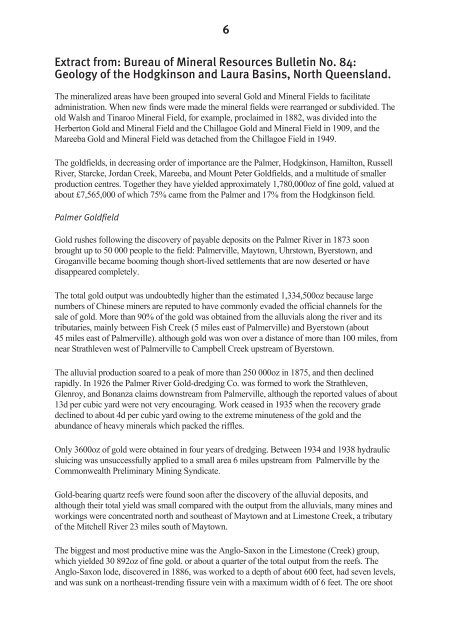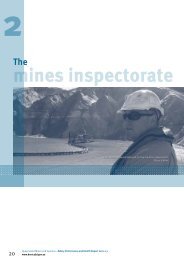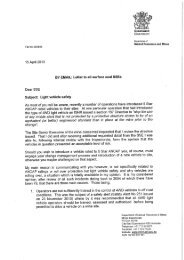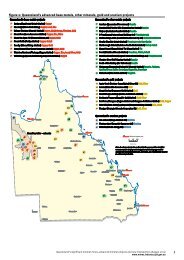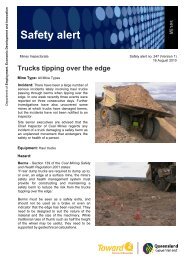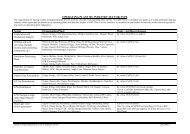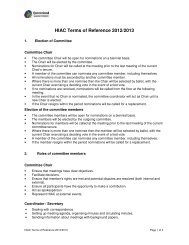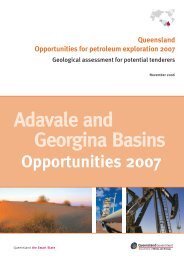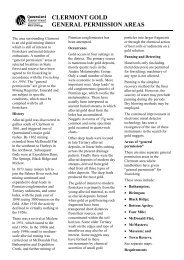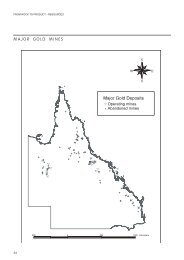Gold in far north Queensland 2 - Queensland Mining and Safety
Gold in far north Queensland 2 - Queensland Mining and Safety
Gold in far north Queensland 2 - Queensland Mining and Safety
Create successful ePaper yourself
Turn your PDF publications into a flip-book with our unique Google optimized e-Paper software.
Extract from: Bureau of M<strong>in</strong>eral Resources Bullet<strong>in</strong> No. 84:<br />
Geology of the Hodgk<strong>in</strong>son <strong>and</strong> Laura Bas<strong>in</strong>s, North <strong>Queensl<strong>and</strong></strong>.<br />
The m<strong>in</strong>eralized areas have been grouped <strong>in</strong>to several <strong>Gold</strong> <strong>and</strong> M<strong>in</strong>eral Fields to facilitate<br />
adm<strong>in</strong>istration. When new f<strong>in</strong>ds were made the m<strong>in</strong>eral fields were rearranged or subdivided. The<br />
old Walsh <strong>and</strong> T<strong>in</strong>aroo M<strong>in</strong>eral Field, for example, proclaimed <strong>in</strong> 1882, was divided <strong>in</strong>to the<br />
Herberton <strong>Gold</strong> <strong>and</strong> M<strong>in</strong>eral Field <strong>and</strong> the Chillagoe <strong>Gold</strong> <strong>and</strong> M<strong>in</strong>eral Field <strong>in</strong> 1909, <strong>and</strong> the<br />
Mareeba <strong>Gold</strong> <strong>and</strong> M<strong>in</strong>eral Field was detached from the Chillagoe Field <strong>in</strong> 1949.<br />
The goldfields, <strong>in</strong> decreas<strong>in</strong>g order of importance are the Palmer, Hodgk<strong>in</strong>son, Hamilton, Russell<br />
River, Starcke, Jordan Creek, Mareeba, <strong>and</strong> Mount Peter <strong>Gold</strong>fields, <strong>and</strong> a multitude of smaller<br />
production centres. Together they have yielded approximately 1,780,000oz of f<strong>in</strong>e gold, valued at<br />
about £7,565,000 of which 75% came from the Palmer <strong>and</strong> 17% from the Hodgk<strong>in</strong>son field.<br />
Palmer <strong>Gold</strong>field<br />
<strong>Gold</strong> rushes follow<strong>in</strong>g the discovery of payable deposits on the Palmer River <strong>in</strong> 1873 soon<br />
brought up to 50 000 people to the field: Palmerville, Maytown, Uhrstown, Byerstown, <strong>and</strong><br />
Groganville became boom<strong>in</strong>g though short-lived settlements that are now deserted or have<br />
disappeared completely.<br />
6<br />
The total gold output was undoubtedly higher than the estimated 1,334,500oz because large<br />
numbers of Ch<strong>in</strong>ese m<strong>in</strong>ers are reputed to have commonly evaded the official channels for the<br />
sale of gold. More than 90% of the gold was obta<strong>in</strong>ed from the alluvials along the river <strong>and</strong> its<br />
tributaries, ma<strong>in</strong>ly between Fish Creek (5 miles east of Palmerville) <strong>and</strong> Byerstown (about<br />
45 miles east of Palmerville). although gold was won over a distance of more than 100 miles, from<br />
near Strathleven west of Palmerville to Campbell Creek upstream of Byerstown.<br />
The alluvial production soared to a peak of more than 250 000oz <strong>in</strong> 1875, <strong>and</strong> then decl<strong>in</strong>ed<br />
rapidly. In 1926 the Palmer River <strong>Gold</strong>-dredg<strong>in</strong>g Co. was formed to work the Strathleven,<br />
Glenroy, <strong>and</strong> Bonanza claims downstream from Palmerville, although the reported values of about<br />
13d per cubic yard were not very encourag<strong>in</strong>g. Work ceased <strong>in</strong> 1935 when the recovery grade<br />
decl<strong>in</strong>ed to about 4d per cubic yard ow<strong>in</strong>g to the extreme m<strong>in</strong>uteness of the gold <strong>and</strong> the<br />
abundance of heavy m<strong>in</strong>erals which packed the riffles.<br />
Only 3600oz of gold were obta<strong>in</strong>ed <strong>in</strong> four years of dredg<strong>in</strong>g. Between 1934 <strong>and</strong> 1938 hydraulic<br />
sluic<strong>in</strong>g was unsuccessfully applied to a small area 6 miles upstream from Palmerville by the<br />
Commonwealth Prelim<strong>in</strong>ary M<strong>in</strong><strong>in</strong>g Syndicate.<br />
<strong>Gold</strong>-bear<strong>in</strong>g quartz reefs were found soon after the discovery of the alluvial deposits, <strong>and</strong><br />
although their total yield was small compared with the output from the alluvials, many m<strong>in</strong>es <strong>and</strong><br />
work<strong>in</strong>gs were concentrated <strong>north</strong> <strong>and</strong> southeast of Maytown <strong>and</strong> at Limestone Creek, a tributary<br />
of the Mitchell River 23 miles south of Maytown.<br />
The biggest <strong>and</strong> most productive m<strong>in</strong>e was the Anglo-Saxon <strong>in</strong> the Limestone (Creek) group,<br />
which yielded 30 892oz of f<strong>in</strong>e gold. or about a quarter of the total output from the reefs. The<br />
Anglo-Saxon lode, discovered <strong>in</strong> 1886, was worked to a depth of about 600 feet, had seven levels,<br />
<strong>and</strong> was sunk on a <strong>north</strong>east-trend<strong>in</strong>g fissure ve<strong>in</strong> with a maximum width of 6 feet. The ore shoot
was 300 to 400 feet long, but the ore became arsenical <strong>in</strong> the lower levels. The grade averaged<br />
1.64 oz of gold per ton with rich patches up to 78 oz per ton.<br />
7<br />
The Maytown reefs <strong>in</strong>clude several groups the largest of which were the Ida, Comet, Louisa,<br />
Queen, <strong>and</strong> Alex<strong>and</strong>er groups. The first crush<strong>in</strong>gs were made <strong>in</strong> 1876, <strong>and</strong> when the m<strong>in</strong>es closed<br />
down some 137,000 oz of f<strong>in</strong>e gold had been obta<strong>in</strong>ed from 80,000 tons of ore, <strong>in</strong>clud<strong>in</strong>g the<br />
production from the Limestone (Creek) group. The grade ranged from 1 to 2 oz per ton. Most of<br />
the m<strong>in</strong>es closed down after 1893 dur<strong>in</strong>g a f<strong>in</strong>ancial crisis <strong>and</strong> were not reopened. An effort to<br />
revive the Louisa m<strong>in</strong>e <strong>in</strong> 1939-40 was unsuccessful because of the troublesome quantities of<br />
m<strong>in</strong>e water, <strong>and</strong> the large amounts of pyrite <strong>and</strong> arsenopyrite <strong>in</strong> the ore which made treatment<br />
difficult.<br />
The m<strong>in</strong><strong>in</strong>g operations on the Maytown lodes met with many difficulties. Timber was scarce <strong>and</strong><br />
of poor quality, transport was very expensive, <strong>and</strong> the cost of liv<strong>in</strong>g exorbitantly high. M<strong>in</strong><strong>in</strong>g was<br />
concentrated on the richest portions of the lodes, <strong>and</strong> little attention was paid to development<br />
work. The reefs were small, <strong>and</strong> though very rich on top were generally impoverished <strong>in</strong> depth:<br />
Water <strong>in</strong> the work<strong>in</strong>gs was difficult to cope with. Jackson, contrary to most other op<strong>in</strong>ions then<br />
current, concluded that most of the payable ore had been exhausted <strong>and</strong> that reopen<strong>in</strong>g of the<br />
m<strong>in</strong>es was unwarranted, but that if the m<strong>in</strong>es were reopened, more reefs should be m<strong>in</strong>ed<br />
simultaneously, us<strong>in</strong>g modern equipment, electric power, <strong>and</strong> cheap oil fuel.<br />
The auriferous reefs are th<strong>in</strong> lenticular quartz-filled fissure ve<strong>in</strong>s with<strong>in</strong> a belt of sheared dark<br />
phyllite <strong>and</strong> greywacke. The thickness ranged from a few <strong>in</strong>ches to about 2 feet. In addition to the<br />
reefs m<strong>in</strong>ed, many th<strong>in</strong> unpayable leaders exist <strong>in</strong> the country rock. The reefs strike <strong>north</strong>west or<br />
<strong>north</strong>-<strong>north</strong>west, <strong>and</strong> dip steeply to the southwest. They are composed of milky ve<strong>in</strong> quartz<br />
conta<strong>in</strong><strong>in</strong>g native gold, some pyrite, arsenopyrite, <strong>and</strong> a little stibnite. It is alleged that there were<br />
generally less base-metal sulphides <strong>in</strong> the Palmer reefs than <strong>in</strong> the lodes on the Hodgk<strong>in</strong>son<br />
<strong>Gold</strong>fie1d.<br />
Jack <strong>and</strong> others have noted that bends <strong>in</strong> the reefs were favourable loci for ore enrichment. It<br />
appears that the grade rapidly decreased <strong>in</strong> depth, especially <strong>in</strong> some of the Queen lodes, but it is<br />
uncerta<strong>in</strong> whether the higher surface values were due to secondary enrichment.<br />
<strong>Gold</strong> also occurs <strong>in</strong> the basal conglomerate of the Mesozoic Dalrymple S<strong>and</strong>stone to the <strong>north</strong> of<br />
the Palmer River, <strong>in</strong> the headwater region of the Mossman River <strong>and</strong> Cradle Creek. Jack reported<br />
the largest areas of auriferous leads above the unconformity along Ch<strong>in</strong>ky Creek, a tributary of the<br />
Mossman River.<br />
The conglomerate is up to 4 or 5 feet thick, <strong>and</strong> fills old stream courses runn<strong>in</strong>g <strong>north</strong> on the<br />
pre-Mesozoic surface of erosion. The gold, where present, is concentrated near the bottom of the<br />
conglomerate. It is water-worn, <strong>and</strong> of high f<strong>in</strong>eness. No production is known to have taken place,<br />
but a considerable amount of development work was done locally. The deposits were tested aga<strong>in</strong><br />
<strong>in</strong> 1936-38, when diesel eng<strong>in</strong>es, a five-head stamp battery, <strong>and</strong> other mach<strong>in</strong>ery were available.<br />
Normal sampl<strong>in</strong>g showed traces of gold only, <strong>and</strong> the best grades found by test m<strong>in</strong><strong>in</strong>g ranged<br />
from 2½ to 5 dwt per ton. These values are considered unsatisfactory as the leads can be exploited<br />
only by hard-rock m<strong>in</strong><strong>in</strong>g methods, the volume of ore is small, the gold content erratic, <strong>and</strong> many<br />
of the leads ill-def<strong>in</strong>ed. The conglomerate is probably the source of the small quantities of alluvial<br />
gold won by prospectors <strong>in</strong> Shepherd Creek <strong>and</strong> the headwaters of the Mossman River.
Recompense<br />
85<br />
MAYTOWN (ru<strong>in</strong>s)<br />
PALMER<br />
Discussion<br />
Thomson’s<br />
Butchers<br />
R<br />
Hop Bitters<br />
Lady Mary<br />
The Maytown gold reefs<br />
Nelson’s<br />
Gully<br />
Gully<br />
Anti-clique<br />
3 Jacks<br />
Alliance<br />
Black Bird<br />
70<br />
Louisa<br />
8<br />
Little Union<br />
Ida<br />
Sc<strong>and</strong><strong>in</strong>avian<br />
Just <strong>in</strong> Time<br />
Hearts Content<br />
Perseverance<br />
Caledonia<br />
The alluvial deposits <strong>and</strong> most of the known reefs on the Palmer <strong>Gold</strong>field can be considered to be<br />
exhausted, <strong>and</strong> the geomorphological history of the area <strong>in</strong>dicates that there is little prospect of<br />
f<strong>in</strong>d<strong>in</strong>g new alluvial deposits west of Palmerville: it is thought that the gold derived from erosion<br />
of the lodes on the pre-Mesozoic erosion surface was pla<strong>in</strong>ly dispersed towards the <strong>north</strong><br />
orig<strong>in</strong>ally, <strong>and</strong> that upwarp or till<strong>in</strong>g caused a change <strong>in</strong> the direction of dra<strong>in</strong>age from <strong>north</strong> to<br />
west.<br />
Comet<br />
Albion<br />
50<br />
K<strong>in</strong>g of the Ranges<br />
Britannia?<br />
Reef show<strong>in</strong>g dip<br />
Strike <strong>and</strong> dip of strata<br />
Diorite dyke<br />
Alluvial work<strong>in</strong>gs<br />
Vehicle track<br />
Build<strong>in</strong>g or hut<br />
0 1 2 km<br />
Caledonian<br />
Mounta<strong>in</strong> Maid<br />
Creek<br />
Keep It Dark<br />
Creek<br />
Hit-or-Miss<br />
Smithfield<br />
50<br />
Capta<strong>in</strong> Cook? Queen of the<br />
North<br />
Vik<strong>in</strong>g<br />
Victoria<br />
K<strong>in</strong>g of<br />
the North
Renewed movement along the Palmerville Fault resulted <strong>in</strong> rejuvenation of the topography of the<br />
Maytown block, <strong>and</strong> excellent traps were formed for the redistributed gold <strong>and</strong> for fresh supplies<br />
of gold from the rapidly erod<strong>in</strong>g reefs <strong>and</strong> leaders. West of Palmerville, however, the topography<br />
rema<strong>in</strong>ed old <strong>and</strong> flat, <strong>and</strong> there would be little concentration of the gold. The f<strong>in</strong>e gra<strong>in</strong>-size of<br />
the gold downstream from Palmerville <strong>in</strong>dicates that it has been carried a long way from its<br />
source.<br />
The source of the alluvial gold <strong>in</strong> the upper parts of the Palmer River, near the former sites of<br />
Uhrstown <strong>and</strong> Byerstown, is uncerta<strong>in</strong>. No lodes have been found here, but there is a multitude of<br />
th<strong>in</strong> quartz leaders from which the gold may have been derived. It is possible, but less likely, that<br />
the metal was shed from the three granite tablel<strong>and</strong>s to the south of the Palmer River.<br />
Hodgk<strong>in</strong>son <strong>Gold</strong>field<br />
Estimates of the total output of gold from the Hodgk<strong>in</strong>son field vary: the highest figure quoted is<br />
about 300 000oz, of which only 12 000 to 40 000oz were obta<strong>in</strong>ed from alluvial sources, mostly<br />
<strong>in</strong> the year 1876. The Hodgk<strong>in</strong>son district, though a smaller gold-produc<strong>in</strong>g field than the Palmer<br />
<strong>Gold</strong>field, was a richer lode-m<strong>in</strong><strong>in</strong>g district. In 1878, one year after the first lodes were opened up,<br />
there were 492 m<strong>in</strong>es on 330 claims, <strong>and</strong> 12 crush<strong>in</strong>g plants with a total of 121 stamp heads. The<br />
ma<strong>in</strong> settlements were K<strong>in</strong>gsborough <strong>and</strong> Thornborough; others <strong>in</strong>cluded Beaconsfield,<br />
Woodville, Stewartstown, <strong>and</strong> Wellesley. Most claims were rel<strong>in</strong>quished with<strong>in</strong> a dozen years,<br />
<strong>and</strong> only a h<strong>and</strong>ful of m<strong>in</strong>es rema<strong>in</strong>ed <strong>in</strong> production <strong>in</strong>termittently until all activities stopped<br />
dur<strong>in</strong>g World War I. In the post-war years there was some sporadic development work, but<br />
production was <strong>in</strong>significant.<br />
More than half of the total output was probably derived from the Tyrconnel <strong>and</strong> General Grant<br />
groups of lodes. The average grade was 17 to 18dwt per ton for the General Grant, <strong>and</strong> 21.7dwt<br />
for the Tyrconnel. The latter was the largest lode worked <strong>in</strong> the district <strong>and</strong> was <strong>in</strong> almost<br />
cont<strong>in</strong>uous production until 1924; its bottom level is at 430 feet, where the grade became<br />
uneconomic. From 1933 to 1937 attempts were made to extract about 14 000 tons of available ore<br />
but work was suspended as the grade of 4.17dwt per ton turned out to be below expectation.<br />
The General Grant was worked until 1910 for 23,120oz of bullion. At a depth of 500 feet the ore<br />
body is 600 feet long. <strong>and</strong> sampl<strong>in</strong>g <strong>in</strong> 1934-37 <strong>in</strong>dicated reserves of 8000 tons averag<strong>in</strong>g 8 dwt<br />
per ton. The grade was not considered to be economic, although there was slight improvement <strong>in</strong><br />
the bottom level. The deepest work<strong>in</strong>gs were 715 feet below surface.<br />
Prior to 1905, the Fly<strong>in</strong>g Pig was the most important producer, <strong>and</strong> yielded 14 930oz of bullion<br />
from 8100 tons of ore.<br />
One of the few persistent m<strong>in</strong>es was the M<strong>in</strong>nie Moxham, later known as the New M<strong>in</strong>nie<br />
Moxham. It was the only produc<strong>in</strong>g m<strong>in</strong>e after World War II, <strong>and</strong> yielded about 450oz of f<strong>in</strong>e<br />
gold <strong>in</strong> 1947-50.<br />
9<br />
Jack noted two ma<strong>in</strong> groups of lodes: those parallel to the strike of the sediments, but cutt<strong>in</strong>g<br />
across the dip; <strong>and</strong> those (ma<strong>in</strong>ly <strong>north</strong>-south) across the strike, <strong>and</strong> dipp<strong>in</strong>g to the west. The<br />
lodes, especially the first group, should not be confused with the conspicuous chert ridges which<br />
were commonly considered to be siliceous dykes or barren gold ve<strong>in</strong>s.
The lodes consist of sheared country rock <strong>in</strong>terleaved with quartz str<strong>in</strong>gers, or quartz ve<strong>in</strong>s<br />
rang<strong>in</strong>g from a few <strong>in</strong>ches to several feet wide. The best gold values seem to occur <strong>in</strong> white platy<br />
quartz with dark slaty seams, as <strong>in</strong> the Tyrconnel m<strong>in</strong>e (<strong>and</strong> also found <strong>in</strong> the Maytown lodes of<br />
the Palmer field). The massive rubbly or blocky quartz appears to conta<strong>in</strong> relatively little gold.<br />
The ve<strong>in</strong>s conta<strong>in</strong> native gold, vary<strong>in</strong>g amounts of stibnite, some pyrite, arsenopyrite, <strong>and</strong> small<br />
quantities of chalcopyrite, sphalerite, <strong>and</strong> galena. The stibnite appears to belong to a younger<br />
phase of hydrothermal activity. In some shoots both gold <strong>and</strong> antimony were m<strong>in</strong>ed, <strong>and</strong> <strong>in</strong> later<br />
years some of the m<strong>in</strong>es changed production from gold to antimony, depend<strong>in</strong>g on market<br />
conditions.<br />
Galena <strong>and</strong> sphalerite were common <strong>in</strong> the Leviathan m<strong>in</strong>e, <strong>and</strong> scheelite was found <strong>in</strong> a few<br />
m<strong>in</strong>es, <strong>in</strong>clud<strong>in</strong>g the Southern Cross <strong>and</strong> Tyrconnel. In the Southern Cross, scheelite was first<br />
noticed at a depth of 90 feet, <strong>and</strong> below this level it was a constant constituent of the quartz<br />
gangue, especially <strong>in</strong> the gold-rich portions. Rare molybdenite is found <strong>in</strong> the Southern Cross, <strong>and</strong><br />
barytes occurs <strong>in</strong> the gangue of the M<strong>in</strong>nie Moxham m<strong>in</strong>e. Appreciable amounts of tourmal<strong>in</strong>e are<br />
present <strong>in</strong> the Southern Cross lode.<br />
There is little evidence of structural or stratigraphic control of the ore shoots. Jensen noted that the<br />
Tyrconnel shoot is located <strong>in</strong> a strong bend of the lode; occasionally a carbonaceous slate forms<br />
the favourable host rock, as <strong>in</strong> the Fly<strong>in</strong>g Pig work<strong>in</strong>gs, where the ore shoot pitches parallel to the<br />
l<strong>in</strong>eation formed by the <strong>in</strong>tersection of the lode with certa<strong>in</strong> kaol<strong>in</strong>ized or carbonaceous slates.<br />
In places there is little surface <strong>in</strong>dication of the presence of a reef. At the Tyrconnel, for example,<br />
the black shale conta<strong>in</strong>s th<strong>in</strong> quartz str<strong>in</strong>gers which widen from a few <strong>in</strong>ches at the surface to<br />
several feet <strong>in</strong> depth.<br />
The available records <strong>in</strong>dicate that the reefs have probably been worked out. The lodes are small<br />
<strong>and</strong> broken, the ore shoots commonly deeper than long, <strong>and</strong> the grade of the rema<strong>in</strong><strong>in</strong>g ore at<br />
depth is apparently too low to be m<strong>in</strong>ed economically.<br />
Production on the Hodgk<strong>in</strong>son field was ma<strong>in</strong>ly from lodes, <strong>and</strong> there was little alluvial gold<br />
compared with the Palmer district. The Hodgk<strong>in</strong>son lodes may represent the upper zone of a<br />
m<strong>in</strong>eralized ve<strong>in</strong> system which has not been eroded sufficiently to provide a copious supply of<br />
free gold. The lack of surface <strong>in</strong>dications supports this hypothesis.<br />
Hamilton <strong>Gold</strong>field<br />
10<br />
The Hamilton <strong>Gold</strong>field, centred on the old settlement of Ebagoola, lies on the <strong>north</strong>western<br />
boundary of the map area, <strong>and</strong> extends <strong>far</strong>ther west. It was the most important of the small<br />
gold-produc<strong>in</strong>g centres discovered <strong>in</strong> the course of the <strong>in</strong>tensified prospect<strong>in</strong>g that followed the<br />
establishment of the rich Palmer <strong>and</strong> Hodgk<strong>in</strong>son fields.<br />
<strong>Gold</strong> was discovered at Ebagoola <strong>in</strong> 1899 by a prospector named John Dickie. Ebagoola<br />
developed as the ma<strong>in</strong> production centre, but the work<strong>in</strong>gs extended as <strong>far</strong> as Potallah Creek, 60<br />
miles to the south-southwest beyond the map area. Production, which climbed to 8300oz of f<strong>in</strong>e<br />
gold <strong>in</strong> 1900, tapered off to less than 1 000oz per year after 1910, <strong>and</strong> the field was ab<strong>and</strong>oned <strong>in</strong><br />
1941. A total output of 47,478oz of f<strong>in</strong>e gold has been recorded, mostly from lode m<strong>in</strong><strong>in</strong>g; there<br />
was little alluvial or colluvial gold. Pyrite, arsenopyrite, galena, <strong>and</strong> copper carbonates were<br />
present <strong>in</strong> some of the lodes.
The country rocks consist of Precambrian schist <strong>in</strong>truded by small irregular bodies <strong>and</strong> dykes of<br />
granite <strong>and</strong> some diorite. Quartz reefs are common, but the auriferous shoots are concentrated near<br />
the boundaries of the <strong>in</strong>trusions, both <strong>in</strong> the granite <strong>and</strong> schist. Most of the reefs strike <strong>north</strong>-south<br />
or <strong>north</strong>-<strong>north</strong>-west.<br />
Russell <strong>Gold</strong>field (from 1905: Russell Extended <strong>Gold</strong>field)<br />
The Russell Extended <strong>Gold</strong>field, one of a group of small fields <strong>in</strong> the jungle-covered mounta<strong>in</strong><br />
area between Cairns <strong>and</strong> Innisfail, has been <strong>in</strong>tensely surveyed geologically. The recorded<br />
production of 26,780oz of f<strong>in</strong>e gold was mostly obta<strong>in</strong>ed from alluvial deposits <strong>in</strong> the form of<br />
narrow terraces along the slopes of the steep-sided valleys of the Coopooroo Creek <strong>and</strong><br />
Wairambah Creek dra<strong>in</strong>age systems, which were buried by late Ca<strong>in</strong>ozoic basalt flows Recent<br />
rejuvenation has re-exposed some of the deposits.<br />
Russell (extended) <strong>Gold</strong>field<br />
Millaa Millaa<br />
Mil<strong>and</strong>a<br />
North<br />
Yungaburra<br />
Mal<strong>and</strong>a<br />
Johnstone<br />
Basalt<br />
Granite<br />
Schist, slate,greywacke<br />
Five<br />
Mile<br />
R<br />
Ck<br />
11<br />
LAMONDS HILL<br />
Five Mile<br />
Work<strong>in</strong>gs<br />
Pu n<br />
n ah<br />
Wonanra<br />
Ck<br />
Ck<br />
Coorpooroo<br />
Topaz<br />
Victoria<br />
Marvel<br />
Boonjie<br />
Towalla<br />
Ck<br />
Just In Time Group<br />
Union<br />
Wairambah<br />
Lady Olive<br />
Ck<br />
Wanaroo Ck<br />
Sampsons<br />
Galteemore<br />
Ki<strong>and</strong>ra<br />
Ck<br />
Astronomer<br />
Coopa<br />
Ck<br />
Ck<br />
R<br />
Russell<br />
0 1 2 km
The native gold is conta<strong>in</strong>ed <strong>in</strong> gravel wash: generally a few feet thick, which is overla<strong>in</strong> by up to<br />
20 feet of s<strong>and</strong>, silt, <strong>and</strong> clay, <strong>and</strong> 40 to 100 feet of basalt. The gravel has been worked by<br />
hydraulic sluic<strong>in</strong>g <strong>and</strong> tunnell<strong>in</strong>g. Development was h<strong>in</strong>dered by the lack of accessible water<br />
(notwithst<strong>and</strong><strong>in</strong>g the copious ra<strong>in</strong>fall), the rough <strong>and</strong> densely vegetated terra<strong>in</strong>, the soft<br />
decomposed ground, <strong>and</strong> the hardness of the gravel where cemented by iron hydroxides. Other<br />
adverse conditions <strong>in</strong>cluded the low grade of the deposits, the extremely f<strong>in</strong>e gra<strong>in</strong> size of the<br />
gold, the scattered nature of the deposits, <strong>and</strong> the thick overburden.<br />
Broadhurst & Garth <strong>in</strong>vestigated the area for Clutha Development Ltd <strong>and</strong> came to the conclusion<br />
that the rema<strong>in</strong><strong>in</strong>g reserves could not be m<strong>in</strong>ed profitably.<br />
For a short period, auriferous quartz lodes were m<strong>in</strong>ed <strong>in</strong> the vic<strong>in</strong>ity of Towalla (now<br />
ab<strong>and</strong>oned), some 21 miles south of the Russell terraces. Production came from small shoots <strong>in</strong><br />
<strong>north</strong>west-trend<strong>in</strong>g lodes <strong>in</strong> the Coolamon Creek area. The reported grade of 2 to 3 oz per ton was<br />
<strong>in</strong>sufficient to counterbalance the high cost of transport <strong>and</strong> the <strong>in</strong>adequacy of the reserves <strong>and</strong> the<br />
lodes were ab<strong>and</strong>oned <strong>in</strong> 1905.<br />
Jordan Creek <strong>Gold</strong>field<br />
The Jordan Creek <strong>Gold</strong>field, situated <strong>in</strong> mounta<strong>in</strong>ous jungle country west of Innisfail, comprises<br />
two separate groups of work<strong>in</strong>gs: the orig<strong>in</strong>al prospects <strong>in</strong> the Jordan Creek <strong>and</strong> Henrietta Creek<br />
area, 10 miles southeast of Millaa Millaa <strong>and</strong> 1 to 2 miles south of the Palmerston Highway: <strong>and</strong> a<br />
later group of work<strong>in</strong>gs <strong>in</strong> the Myee Creek area, <strong>north</strong> of the highway, 7 miles southeast of Millaa<br />
Millaa.<br />
The gold is conta<strong>in</strong>ed <strong>in</strong> small quartz ve<strong>in</strong>s <strong>and</strong> leaders <strong>in</strong> decomposed granite. In places there is a<br />
slightly auriferous altered zone up to 10 feet wide around the quartz ve<strong>in</strong>s. Assays are reported to<br />
have shown 1 to 2oz of f<strong>in</strong>e gold per ton, but the average recovery grade was much less. Many of<br />
the th<strong>in</strong> leaders are manganiferous, <strong>and</strong> a little pyrite <strong>and</strong> arsenopyrite are also present.<br />
The Jordan Creek/Henrietta Creek lodes are arranged en echelon <strong>in</strong> a <strong>north</strong>-<strong>north</strong>-east trend<strong>in</strong>g<br />
belt; they may have been formed <strong>in</strong> tension fissures caused by a dextral shear couple.<br />
Much of the 12,750oz of f<strong>in</strong>e gold produced was won from alluvial deposits <strong>in</strong> creeks which have<br />
been worked out long ago: all recent production, amount<strong>in</strong>g to several tens of ounces per year, has<br />
been derived from lodes ma<strong>in</strong>ly <strong>in</strong> the Myee Creek area.<br />
Some prospect<strong>in</strong>g has been done on a few deep leads under the basalt cover<strong>in</strong>g the granite, but the<br />
gold values are not high, <strong>and</strong> the tunnels need much timber<strong>in</strong>g on account of the soft ground.<br />
Starcke No. 1 <strong>and</strong> No.2 <strong>Gold</strong>fields<br />
In 1890 alluvial gold was discovered <strong>in</strong> Digg<strong>in</strong>gs (or Diggills) Creek, a branch of the Starcke<br />
river, 25 miles <strong>north</strong>-west of Cape Flattery; 2300oz were recovered before the deposits were<br />
exhausted <strong>in</strong> 1895.<br />
12<br />
A smaller alluvial deposit was found <strong>in</strong> 1896 at Munburra, <strong>far</strong>ther downstream, <strong>and</strong> this led to the<br />
discovery of the auriferous quartz reefs immediately to the <strong>north</strong>. Between 1898 <strong>and</strong> 1908 the<br />
reefs yielded 9190oz of f<strong>in</strong>e gold from 4858 tons of ore. The field (Starcke No. 2 <strong>Gold</strong>field) was<br />
practically ab<strong>and</strong>oned by 1909.
The cessation of m<strong>in</strong><strong>in</strong>g seems to have been brought about by poor management, the small scale<br />
of the operations, the high treatment costs, <strong>and</strong> poor recovery from the battery, <strong>and</strong> the <strong>in</strong>creased<br />
difficulties of m<strong>in</strong><strong>in</strong>g below the water table. Few m<strong>in</strong>es were worked below the water table at a<br />
depth of 50 to 100 feet, <strong>and</strong> the deepest work<strong>in</strong>gs were about 150 feet. Only high-grade ore,<br />
exceed<strong>in</strong>g 1 to 2oz per ton, could be treated economically, <strong>and</strong> there may rema<strong>in</strong> fairly large<br />
orebodies carry<strong>in</strong>g ½ to 1oz of gold per ton (Ball, 1909e). An attempt to develop one of the<br />
Munburra m<strong>in</strong>es <strong>in</strong> later years is recorded by Beck but no further results have been reported.<br />
The white quartz ve<strong>in</strong>s are commonly about a foot wide, <strong>and</strong> occur <strong>in</strong> the steeply dipp<strong>in</strong>g,<br />
<strong>north</strong>-strik<strong>in</strong>g greywacke <strong>and</strong> slate of the Hodgk<strong>in</strong>son Formation. The dip of the ve<strong>in</strong>s is variable,<br />
<strong>and</strong> the strike ranges from south-west to <strong>north</strong>-<strong>north</strong>-west. They are generally closely associated<br />
with oblique to subconcordant grey silicified quartz porphyry dykes which postdate the<br />
development of cleavage <strong>in</strong> the Hodgk<strong>in</strong>son formation. The ve<strong>in</strong>s are fissure <strong>and</strong> replacement<br />
ve<strong>in</strong>s with fragments <strong>and</strong> screens of brecciated country rock partly or wholly replaced by a mosaic<br />
of f<strong>in</strong>e quartz. Other gangue m<strong>in</strong>erals are arsenopyrite, pyrite, <strong>and</strong> sheets of calcite. Stibnite <strong>and</strong><br />
cervantite were probably fairly common <strong>in</strong> the gold lodes, though they have not often been<br />
reported.<br />
Mareeba <strong>Gold</strong> <strong>and</strong> M<strong>in</strong>eral Field<br />
A small field, 5 miles south-east from the Mareeba railway station, produced 11,846oz of f<strong>in</strong>e<br />
gold, most of it from the Queen Constance lode, a <strong>north</strong>-<strong>north</strong>-west trend<strong>in</strong>g, rather flatly dipp<strong>in</strong>g<br />
quartz reef st<strong>and</strong><strong>in</strong>g out as the crest of a low hill. The country rock consists of slate <strong>and</strong> phyllite of<br />
the Barron River Metamorphics. After an <strong>in</strong>itial production of 1770oz <strong>in</strong> one year, the grade fell to<br />
less than 1oz per ton, <strong>and</strong> after struggl<strong>in</strong>g on for another 8 or 9 years the field was ab<strong>and</strong>oned.<br />
Mount Peter <strong>Gold</strong>field<br />
Some 11 000oz of f<strong>in</strong>e gold were obta<strong>in</strong>ed from half a dozen irregular quartz lodes discovered <strong>in</strong><br />
1915 on the steep <strong>north</strong>ern slope of Mount Peter, 3 miles west of Gordonvale. The lodes trend<br />
<strong>north</strong>-east <strong>and</strong> east-south-east across the regional strike of the Barron River Metamorphics. <strong>and</strong><br />
conta<strong>in</strong> shoots that are small <strong>and</strong> widely spaced. The average recovery grade was 1oz 18 dwt per<br />
ton, though values of 41oz per ton were reported <strong>in</strong> some of the shoots. There was little activity<br />
after 1951.<br />
Mulgrave <strong>Gold</strong>field<br />
13<br />
Discovered <strong>in</strong> 1879, the Mulgrave <strong>Gold</strong>field is the oldest of the smaller gold-produc<strong>in</strong>g areas, but<br />
its total recorded yield of 5580 oz is <strong>in</strong>significant. Both alluvial <strong>and</strong> reef deposits were worked.<br />
Production was ma<strong>in</strong>ly alluvial, whereas lode m<strong>in</strong><strong>in</strong>g was never successful because most of the<br />
reefs were low grade, <strong>and</strong> crush<strong>in</strong>gs showed poor returns notwithst<strong>and</strong><strong>in</strong>g promis<strong>in</strong>g assay results.<br />
The lodes consist of narrow quartz reefs, generally ½ to 1½ feet thick, trend<strong>in</strong>g across <strong>and</strong> also<br />
subparallel to the strike of the enclos<strong>in</strong>g Barron River Metamorphics. The work<strong>in</strong>gs, <strong>and</strong> the old<br />
m<strong>in</strong><strong>in</strong>g township of <strong>Gold</strong>sborough on the west bank of the Mulgrave River were deserted after<br />
1905.<br />
Alluvial deposits occur under the basalts on top of the spur separat<strong>in</strong>g South Toohey Creek from<br />
Butcher Creek, 8 miles east of Peeramon at the edge of the basalt-covered Atherton Tablel<strong>and</strong>. At<br />
least three levels of wash were recognized by W. C. Ball: the basalt cover is th<strong>in</strong> or absent <strong>in</strong>
places. Little systematic geological work has been done <strong>in</strong> this area, although Ball believes that<br />
the wash forms a practically cont<strong>in</strong>uous sheet under the basalt.<br />
Fluorspar Locality<br />
The gold m<strong>in</strong><strong>in</strong>g centre of Fluorspar is 10 miles south-east from Chillagoe. The lodes are <strong>in</strong><br />
adamellite near its contact with the Featherbed Volcanics. <strong>and</strong> have produced some 5050oz of<br />
mixed bullion <strong>and</strong> f<strong>in</strong>e gold.<br />
Tate <strong>Gold</strong>field<br />
The Tate <strong>Gold</strong>field is mentioned <strong>in</strong> the Warden’s reports <strong>and</strong> Annual Reports of the Department<br />
of M<strong>in</strong>es for the first few years of the 20th century. Prospect<strong>in</strong>g for alluvial gold was carried out<br />
between Mount McDevitt <strong>and</strong> the Tate River, <strong>and</strong> Skertchly has described a rich but very small<br />
quartz ve<strong>in</strong> <strong>in</strong> the Precambrian rocks 2 miles west of the Tate telegraph station, from which about<br />
600 to 700 oz of gold were recovered. The best yield from the Tate area was 2000 oz <strong>in</strong> 1901:<br />
before <strong>and</strong> after that, the annual production was only several tens of ounces until about 1905.<br />
Alice River (Philp) <strong>Gold</strong>field<br />
The reefs <strong>in</strong> the very short-lived Alice River <strong>Gold</strong>field, roughly 120 to 130 miles west of<br />
Cooktown. form two ma<strong>in</strong> <strong>north</strong>-south l<strong>in</strong>es about half a mile apart. They may be aligned along a<br />
fault zone. The country rock is reported to be granite. Discovered <strong>in</strong> 1904, the field produced<br />
about 2765 oz of f<strong>in</strong>e gold ma<strong>in</strong>ly between 1904 <strong>and</strong> 1909, <strong>and</strong> was deserted soon afterwards.<br />
Mount W<strong>and</strong>oo<br />
The available <strong>in</strong>formation on Mount W<strong>and</strong>oo, 10 miles west from Mungana, has been<br />
summarized by de Keyser & Wolff. Production figures are lack<strong>in</strong>g, except for the years 1933-37<br />
when 2100 oz were obta<strong>in</strong>ed. The work<strong>in</strong>gs occur <strong>in</strong> altered Precambrian ferrug<strong>in</strong>ous <strong>and</strong><br />
micaceous gneiss <strong>and</strong> schist, <strong>and</strong> have been m<strong>in</strong>ed <strong>in</strong>termittently s<strong>in</strong>ce 1901.<br />
Bartle Frere Work<strong>in</strong>gs<br />
The last field to be discovered, <strong>and</strong> one of the least successful, was the Bartle Frere field, 7 miles<br />
west of Bab<strong>in</strong>da. The reefs occur <strong>in</strong> the Barron River Metamorphics at the <strong>north</strong>ern foot of Mount<br />
Bartle Frere. The gold is conta<strong>in</strong>ed <strong>in</strong> steeply dipp<strong>in</strong>g quartz reefs subparallel with, or <strong>in</strong> places<br />
transect<strong>in</strong>g, the regional strike of the sediments. Assay values generally ranged from 1 to 3 oz per<br />
ton, but the shoots were small, patchy, <strong>and</strong> irregular, <strong>and</strong> the cost of transport was high; the field<br />
was deserted after 1942, hav<strong>in</strong>g yielded only 520 oz of f<strong>in</strong>e gold.<br />
Other <strong>Gold</strong> Prospects<br />
<strong>Gold</strong> has been won <strong>in</strong> small quantities, or traces of gold have been reported, from many other<br />
localities.<br />
14<br />
In 1921, gold was discovered south of Six Mile Creek 4¼ miles southwest of Cooktown. The<br />
lodes strike west-<strong>north</strong>-west <strong>and</strong> <strong>north</strong>-south <strong>and</strong> the grade of the ore ranges from 1 to 4½oz per<br />
ton.
R<strong>and</strong>alls m<strong>in</strong>e, or the Freedom, is a quartz lode 8 miles south-west of Molloy. It was worked from<br />
1939 to 1941 for a yield of about 650oz of gold <strong>and</strong> 100oz of silver from 230 tons of ore.<br />
Three small quartz lodes have been reported from the Mitchell River area south of Curraghmore<br />
homestead. The quartz is iron-sta<strong>in</strong>ed <strong>in</strong> places, <strong>and</strong> conta<strong>in</strong>s free gold, pyrite, <strong>and</strong> galena.<br />
Other small gold ve<strong>in</strong>s have been reported from the Ch<strong>in</strong>a Camp area (the Enterprise m<strong>in</strong>e), 12<br />
miles <strong>north</strong> of Da<strong>in</strong>tree: from around Racecourse Mounta<strong>in</strong> between Diggers Creek <strong>and</strong> the West<br />
Normanby River; <strong>and</strong> at Nolans Creek where some gold is associated with cobalt, bismuth, <strong>and</strong><br />
arsenopyrite <strong>in</strong> low-grade pipe-like orebodies. Rich but small gold reefs have been reported <strong>in</strong><br />
diorite <strong>in</strong> the Gurrumba/Ord area southwest of Emuford.<br />
Between 1894 <strong>and</strong> 1898 attempts were made to work the low-grade quartz lodes at the Clohesy<br />
River <strong>north</strong>-east of Mareeba. One shaft was sunk below 100 feet, but as the grade averaged only<br />
½oz per ton the prospect was ab<strong>and</strong>oned. Another shaft was sunk to 135 feet at Kamerunga <strong>in</strong><br />
1933-34, but the prospect was soon closed down because of the irregular grade <strong>and</strong> the abundance<br />
of m<strong>in</strong>e water.<br />
At Mount Mascotte, 8 miles east-south-east of Atherton, about 200 oz of f<strong>in</strong>e gold were m<strong>in</strong>ed<br />
from a quartz lode <strong>in</strong> a small <strong>in</strong>lier of chiastolite schist <strong>in</strong> the Atherton Basalt.<br />
Alluvial gold was won from the Tully River <strong>and</strong> from Culpa Creek, one of its tributaries, between<br />
1894 <strong>and</strong> 1905; <strong>and</strong> from S<strong>and</strong>y Creek, a tributary of the North Johnstone River. Small quantities<br />
of gold have been found <strong>in</strong> most of the streams dra<strong>in</strong><strong>in</strong>g the granite massifs west <strong>and</strong> south-west<br />
of Mossman; <strong>and</strong> <strong>in</strong> the St Georges River <strong>and</strong> its tributaries, F<strong>in</strong>e <strong>Gold</strong> Creek, <strong>and</strong> Hurricane<br />
Creek.<br />
Sluic<strong>in</strong>g prospects have been tested <strong>in</strong> the Russell River where it enters the coastal pla<strong>in</strong>; <strong>in</strong> the<br />
North Johnstone River 8 miles west of Innisfail; <strong>and</strong> <strong>in</strong> creek alluvium at Eubanangee, 7 miles<br />
<strong>north</strong>west of Innisfail. Farther south, a little alluvial gold has been found <strong>in</strong> the headwaters of<br />
Yamanie Creek <strong>and</strong> Smoko Creek, tributaries of the Herbert River, <strong>and</strong> <strong>in</strong> the t<strong>in</strong> deposits on<br />
Broadwater Creek west of Cardwell. The Herbert River Gorge, west of the area mapped, has also<br />
been prospected for gold.<br />
Traces of gold have been reported from a creek about 2 miles south of N<strong>in</strong>ian Bay <strong>in</strong> association<br />
with native copper <strong>and</strong> silver <strong>in</strong> a thermal spr<strong>in</strong>g deposit on Noble Isl<strong>and</strong> <strong>and</strong> at White Rock south<br />
of Cairns.<br />
Much gold was obta<strong>in</strong>ed as a by-product from the copper m<strong>in</strong>es at Cardross, 20 miles<br />
west-<strong>north</strong>-west of Mungana, <strong>and</strong> <strong>in</strong> much smaller amounts from other copper m<strong>in</strong>es <strong>in</strong> the<br />
Chillagoe area.<br />
15
Name<br />
(Year of discovery<br />
Palmer <strong>Gold</strong>field (1873)<br />
Hodgk<strong>in</strong>son <strong>Gold</strong>field (1875)<br />
Hamilton <strong>Gold</strong>field (1899)<br />
Russell <strong>Gold</strong>field (1887)<br />
(Also known as ‘Russell<br />
Terraces’, ‘Topaz’, ‘Boonjie’).<br />
In 1905 <strong>in</strong>cluded <strong>in</strong> Russell<br />
Extended<br />
Location Estimated Production<br />
(f<strong>in</strong>e oz)<br />
Palmer R., about 110 miles<br />
WNW of Cairns<br />
Description M<strong>in</strong>erals<br />
1,334,500 (a) (Alluvial deposits, ma<strong>in</strong>ly between Fish Cr. Junction<br />
<strong>and</strong> Byerstown. Provided over 90% of total production<br />
Maytown (b) (Quartz reefs, Maytown area - th<strong>in</strong> lenticular fissure<br />
ve<strong>in</strong>s <strong>in</strong> sheared phyllite <strong>and</strong> greywacke. Reefs strike NW <strong>and</strong><br />
NNW, dip steeply SW. Ma<strong>in</strong> reef systems: Ida-Comet, Louisa,<br />
Queen, Alex<strong>and</strong>er. Average grade 1-2 oz per ton.<br />
25 miles S of Maytown (c) (Quartz reefs. Limestone district. Ma<strong>in</strong> m<strong>in</strong>e was<br />
Anglo-Saxon, on reef strik<strong>in</strong>g NE <strong>and</strong> worked to depth of 600 ft.<br />
This was biggest m<strong>in</strong>e <strong>in</strong> Palmer <strong>Gold</strong>field<br />
North of Maytown (d) (Deep leads <strong>in</strong> basal conglomerate of Dalrymple<br />
S<strong>and</strong>stone <strong>in</strong> headwaters of Mossman R. <strong>and</strong> Cradle Cr., N of<br />
Maytown. Prospected, but not brought <strong>in</strong>to production because of<br />
low <strong>and</strong> erratic values<br />
Hodgk<strong>in</strong>son R., 50 miles W of<br />
Cairns<br />
Around Ebagoola, an old<br />
settlement 30 miles W of<br />
Pr<strong>in</strong>cess Charlotte Bay<br />
Headwaters of Russell R., 10<br />
miles ESE of Mal<strong>and</strong>a. Lodes<br />
at Towalla, 13 miles SE of<br />
Mal<strong>and</strong>a.<br />
Jordan Creek <strong>Gold</strong>field (1898) 1. Jordan Cr./Henrietta<br />
Cr. area, 10 miles SE of<br />
Millaa Millaa<br />
2. Myee Cr. area. 7<br />
miles SE of Millaa Millaa<br />
about 300,000 (a) (Alluvial deposits. Yielded roughly 10% only of total<br />
production.<br />
(b) (Quartz reefs; two ma<strong>in</strong> groups:<br />
(a) (parallel to strike but cutt<strong>in</strong>g across dip;<br />
(b) (across strike, <strong>and</strong> dipp<strong>in</strong>g to W<br />
Important lode systems: Tyrconnel, General Grant,<br />
Fly<strong>in</strong>g Pig. Average grade about 1 oz per ton. Maximum depth of<br />
work<strong>in</strong>gs 715 ft<br />
47,480 Ma<strong>in</strong>ly lode m<strong>in</strong><strong>in</strong>g; very little alluvial (colluvial) gold. Most of<br />
gold-quartz reefs strike N or NNW <strong>and</strong> are located near granite<br />
contacts. Important centres: Yarraden, Ebagoola, <strong>and</strong> Potallah Cr.<br />
26,780 (a) (Buried alluvial deposits <strong>in</strong> late Ca<strong>in</strong>ozoic terraces along<br />
sides of steep valleys. Auriferous basal gravels overla<strong>in</strong> by up to<br />
20ft of s<strong>and</strong>, silt, <strong>and</strong> clay, under cover of 40-100ft of basalt.<br />
Latest work<strong>in</strong>gs: Astronomer, Marvel, Lady Olive<br />
(b) (Quartz reefs, strik<strong>in</strong>g NW generally less than 1ft<br />
thick, dip almost vertical <strong>in</strong> decomposed Barron River<br />
Metamorphics. Grade 2-3oz per ton, but shoots very small<br />
12,780 (to end 1966) (a) (Recent creek alluvium, now exhausted<br />
(b) (Quartz ve<strong>in</strong>s <strong>and</strong> leaders <strong>in</strong> decomposed granite,<br />
<strong>in</strong> places with slightly auriferous alteration haloes. Reefs<br />
generally trend NE, thickness 6<strong>in</strong>-1ft. Values up to 2oz per<br />
ton, but average grade much less. Biggest m<strong>in</strong>e: Wyreema<br />
(J.B.J. m<strong>in</strong>e or Two Ts Lease)<br />
(c) (Some deep leads under basalt. Prospect only<br />
<strong>Gold</strong>. Some pyrite,<br />
arsenopyrite, a little stibnite.<br />
Gangue: quartz<br />
<strong>Gold</strong>. Pyrite, arsenopyrite<br />
<strong>Gold</strong>, stibnite. Some pyrite,<br />
arsenopyrite, chalcopyrite,<br />
sphalerite, galena. Locally rare<br />
molybdenite, some scheelite<br />
<strong>Gold</strong>. Some pyrite,<br />
arsenopyrite, galena, copper<br />
carbonates<br />
<strong>Gold</strong>, cassiterite<br />
<strong>Gold</strong> <strong>in</strong> quartz gangue.<br />
Some pyrite<br />
<strong>Gold</strong>. Manganese oxides,<br />
some pyrite, arsenopyrite<br />
16
Name<br />
(Year of discovery<br />
Starcke No. 1 <strong>Gold</strong>field<br />
(1892)<br />
Starcke No. 2 <strong>Gold</strong>field<br />
(1890)<br />
Location Estimated Production<br />
(f<strong>in</strong>e oz)<br />
Cocoa Cr., 30 miles NW of<br />
Cooktown<br />
Starcke E. 45 miles NNW of<br />
Cooktown<br />
Description M<strong>in</strong>erals<br />
1100 <strong>Gold</strong>-stibnite-quartz ve<strong>in</strong>s. Ma<strong>in</strong> lode strikes WNW <strong>Gold</strong>, stibnite<br />
13,000 (a) (Alluvial deposits at Digg<strong>in</strong>s Cr. <strong>and</strong> Munburra<br />
(b) (Quartz reefs N <strong>and</strong> E of Munburra. Grade almost<br />
1.9oz per ton <strong>Gold</strong>. Arsenopyrite, pyrite,<br />
stibnite<br />
Mareeba <strong>Gold</strong>field (1893) 5 miles SE of Mareeba 11,850 Quartz lodes. Only important m<strong>in</strong>e was Queen Constance <strong>in</strong> which<br />
lode trends NNW, <strong>and</strong> has flat dip<br />
Mount Peter <strong>Gold</strong>field (1915)<br />
Mulgrave <strong>Gold</strong>field (1879)<br />
Fluorspar<br />
(1930)<br />
Tate <strong>Gold</strong>field (about 1895)<br />
Alice River (or Philp<br />
<strong>Gold</strong>field (1904)<br />
Mount W<strong>and</strong>oo (1901?)<br />
Bartle Frere work<strong>in</strong>gs (1937)<br />
3 miles W of Gordonvale on<br />
steep N slopes of Mt Peter<br />
12-16 miles SSW of<br />
Gordonvale along spur at<br />
watershed between South<br />
Toohey Cr. <strong>and</strong> Butcher Cr.,<br />
<strong>and</strong> along Mulgrave R<br />
10 miles SE of Chillagoe, on<br />
Crooked Cr.<br />
Tate R. area, about 30 miles<br />
SW of Chillagoe<br />
Roughly 120-130 miles W of<br />
Cooktown, on Dickies Cr<br />
17 miles W of Chillagoe on<br />
W<strong>and</strong>oo Cr<br />
7 miles W of Bab<strong>in</strong>da, at foot<br />
of Mt Bartle Frere<br />
11,000 Irregular quartz reefs trend<strong>in</strong>g NE <strong>and</strong> ESE across regional strike<br />
of enclos<strong>in</strong>g Barron River Metamorphics. Steep dips. Shoots small<br />
<strong>and</strong> widely spaced. Average grade: 1oz 18dwt per ton. Large lode:<br />
the Talisman<br />
5580 (a) (Recent alluvium, now exhausted<br />
(b) (Quartz reefs, 6<strong>in</strong>.-11/2ft thick, with irregular ore<br />
shoots, <strong>and</strong> subparallel with, or diagonal to, strike of<br />
enclos<strong>in</strong>g Barron River Metamorphics<br />
(c) (Buried alluvial deposits similar to those of<br />
Russell <strong>Gold</strong>field. Little <strong>in</strong>formation available<br />
Unknown, but at least 5050<br />
(mixed bullion <strong>and</strong> f<strong>in</strong>e gold)<br />
Small, but commonly extremely rich shoots <strong>in</strong> th<strong>in</strong> leaders where<br />
these cut through greisenized gently dipp<strong>in</strong>g aplite ve<strong>in</strong>s <strong>in</strong><br />
adamellite. <strong>Gold</strong> concentrated <strong>in</strong> kaol<strong>in</strong>-rich patches; values many<br />
ounces per ton<br />
At least 3370 Alluvial, <strong>and</strong> rich but extremely small quartz ve<strong>in</strong>s <strong>in</strong> Precambrian<br />
rocks<br />
2765 Two ma<strong>in</strong> lodes (Alice <strong>and</strong> St Aignan), 1/2 mile apart <strong>in</strong> N-S<br />
direction, <strong>and</strong> probably part of same N-S fault zone. Many parallel<br />
reefs <strong>and</strong> leaders. Reef 4-5ft wide<br />
Unknown; 2100 from 1933-37 Ma<strong>in</strong> work<strong>in</strong>gs with<strong>in</strong> zone of altered ferrug<strong>in</strong>ous <strong>and</strong> micaceous<br />
gneiss, about 14 cha<strong>in</strong>s long, m<strong>in</strong>eral impregnated. M<strong>in</strong>eralization<br />
concentrated <strong>in</strong> fissure deposits <strong>and</strong> <strong>in</strong> pipes formed at<br />
<strong>in</strong>tersections of jo<strong>in</strong>ts <strong>and</strong> fissures. Fissures much splayed, <strong>and</strong><br />
sometimes referred to as stockworks. Maximum depth of work<strong>in</strong>gs<br />
2ft<br />
520 Quartz reefs subparallel with, or <strong>in</strong> places diagonal to, strike of<br />
surround<strong>in</strong>g Barron River Metamorphics. Shoots patchy <strong>and</strong><br />
irregular<br />
<strong>Gold</strong>. Some pyrite, rare<br />
sphalerite, stibnite<br />
<strong>Gold</strong>. Little chalcopyrite,<br />
pyrite, arsenopyrite<br />
<strong>Gold</strong>. Little pyrite, galenda<br />
<strong>Gold</strong>. Gangue; kaol<strong>in</strong>, quartz,<br />
calcite, fluorite, zeolites, clay<br />
m<strong>in</strong>erals<br />
<strong>Gold</strong>. Gangue: quartz<br />
<strong>Gold</strong> <strong>in</strong> quartz gangue<br />
<strong>Gold</strong> <strong>in</strong> arsenopyrite, pyrite,<br />
chalcopyrite. Gangue:<br />
ferrug<strong>in</strong>ous <strong>and</strong> kaol<strong>in</strong>ized<br />
country rock<br />
<strong>Gold</strong> <strong>in</strong> quartz gangue. Little<br />
pyrite, arsenopyrite, galena,<br />
sphalerite, chalcopyrite<br />
17


